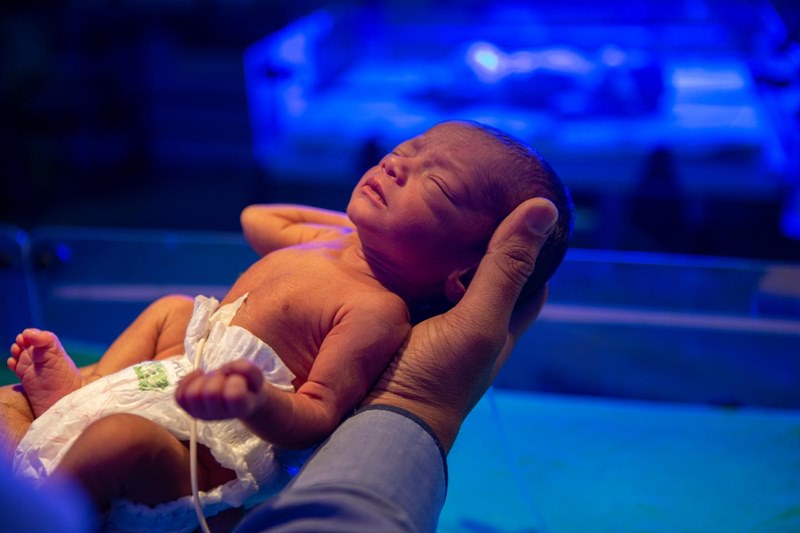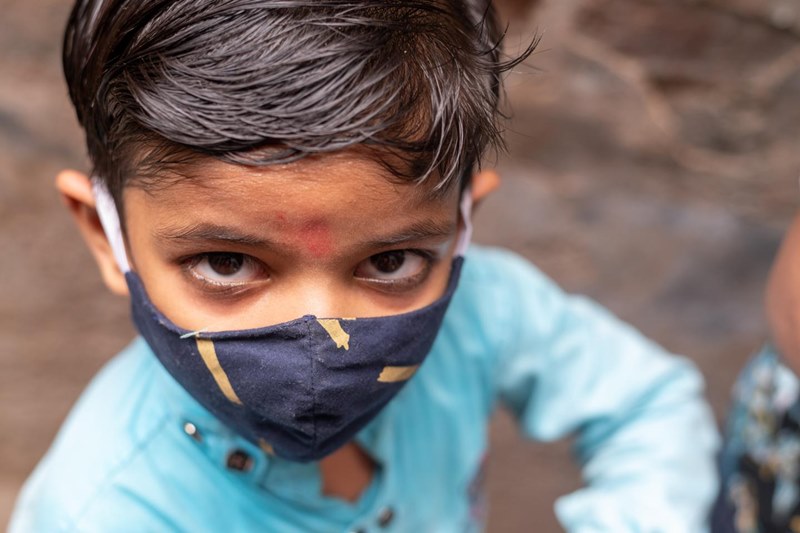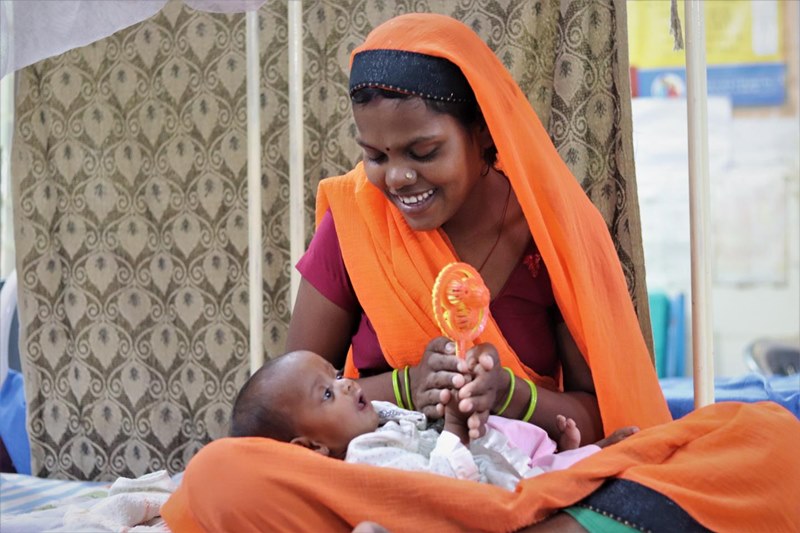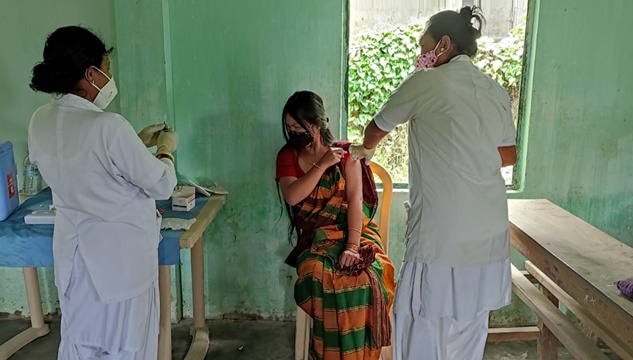‘Third wave may peak in India in October; paediatric facilities nowhere close to what is required’
A recent report by the National Institute of Disaster Management points out that the existing pediatric health care facilities, especially in rural India, are not robust enough to treat children on a large scale. It also reveals how rural women are marginally placed vaccination-wise and the need to ramp up health services in rural India.


The experts suggested immediately increasing paediatric medical capacities in India. Photo: Unicef India
Indicating that a possible ‘third wave’, which is being feared to affect children the most, may peak in October this year, a recent report by a government body has pointed out that paediatric facilities such as doctors, ventilators, ambulances, are ‘nowhere close to what may be required’ in case a large number of kids get infected with the coronavirus.
Prepared by the National Institute of Disaster Management (NIDM), a government agency for managing natural disasters in India, the report titled ‘COVID-19 Third Wave Preparedness: Children’s Vulnerability And Recovery’, assesses possible scenarios in the event of a possible third wave and proposes solutions for addressing the gaps therein.
While discussing various scenarios, the NIDM report quotes a 2015 parliamentary standing committee report that shows there is an 82 per cent shortage of paediatricians in India’s primary health centres and up to 62.8 per cent of positions for paediatricians in community health centres were vacant.
This recent report draws recommendations from the experts during various consultative meetings organised by NIDM. The working group committee experts have suggested a holistic home care model, immediate increase in paediatric medical capacities and suggested that COVID19 wards should have to be structured in a way that allows children’s attendants or parents to safely stay with them through their recovery.
Meanwhile, recently, Union Information and Broadcasting Minister Anurag Thakur had said the central government was fully prepared to deal with a possible third wave and special emphasis was being laid on strengthening paediatric care.

Third wave scenarios
The NIDM report focuses on Indian Institute of Technology-Kanpur (IIT Kanpur) predictions on three scenarios for the third wave based on the level of unlocking.
If the situation is ‘back to normal’, notes the report, then a third wave peak is expected in October this year. However, it is expected that the country would see a lower peak (320,000 cases per day) than the second wave (400,000 cases per day).
If new and more virulent variants emerge, then the peak is expected in the next month, September with 500,000 cases per day, higher than the second wave.
But if ‘strict interventions’ are taken, the peak could be delayed to late October, with 200,000 cases per day, lower than the second wave surge.

Unvaccinated children a cause for worry
Many health experts had initially raised concerns about the possibility of a third wave affecting children more adversely than adults.
The NIDM report revealed that there is no biological evidence that the current and the new Delta Plus variant will affect children more disproportionately than adults.
“But there is a cause for worry if not panic according to public health experts, since the children below 18 years remain unvaccinated in India. Also, the existing pediatric health care facilities are not robust enough to treat children on a large scale,” stated the report.

The experts committee recommended vaccination among young children and children with comorbidities should be an ‘immediate’ future priority.
It is to be noted that the drug regulators in India have recently approved Zydus Cadila’s ZyCoV-D vaccine for children above 12 years of age. However, the drive is yet to begin. Earlier, Union Health Minister Mansukh Mandaviya had hinted that children may start receiving their doses against the virus from September.

Reopening of schools and fear of third wave
Several states such as Punjab, Chattisgarh, Madhya Pradesh have reopened schools as COVID19 cases continue to decrease. While classes for 9 to 12 grades have already reopened in Uttar Pradesh, classes 6 to 8 have started from today August 23 and classes 1 to 5 are set to restart from September 1.
With reopening of schools, the looming threat of third wave on unvaccinated children has become a point of contention across the country. Experts suggest that teachers and school staff must be vaccinated as essential workers throughout the country.
Meanwhile, the NIDM report has also underlined the issue of school education for the rural kids. The experts recommended there is a need to have policies to include rural children in online education.
‘Need to ramp up response for rural India’
The disaster management institute’s report has also underlined the issue of weak public infrastructure with severe shortages in qualified medical staff especially for children.
It highlights that there is ‘a huge gap’ between urban and rural India in terms of awareness, digitisation and medical facilities. Hence, the “government must prioritise rural India and vulnerable groups in order to cope with the ongoing pandemic.”

The experts have recommended a need to ramp up health facilities in rural India along with tier-I and tier-II cities in order to contain the further spread of the disease. According to them, this can be done through:
- Effective implementation of public health principles (test, isolate and treat) down to the taluka and village level.
- Vacant positions at primary and community health centres to be filled on priority basis, paediatric care to be available at community and primary health centres level.
- Strengthening the community and primary health centres not only with oxygen but also providing better quality of bed, water, food, toilets.
- Infection, Prevention and Control (IPC) measures are critical especially in the rural areas as the second surge witnessed COVID19 wards with staff without PPE kits, along with patients’ relatives inside those COVID19 wards at a visibly high risk of catching infections while caregiving.
Also Read: Running out of breath as scramble for oxygen cylinders begins
Rural India has to be well connected with the hospitals and ambulance service along with well trained paramedic personnel, recommends the NIDM report.

Disparity in vaccination
So far, 582 million COVID19 vaccines have been administered in India of which 46.8 per cent doses were administered to women.
The recent report has highlighted how rural women are marginally placed vaccination-wise in the country. The experts committee pointed out the requirement of husband or male guardian’s ‘permission’ as one of the reasons for the current gender disparity in vaccine coverage (54 per cent in men and 46 per cent in women).
Other reasons include hesitancy due to rumours about side effects on fertility, menstruation; inaccessibility to technology due to a clear digital gender divide; lack of mobility, and company to visit vaccination centres and undervaluing of her health by family members among others.

